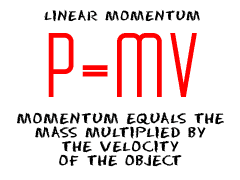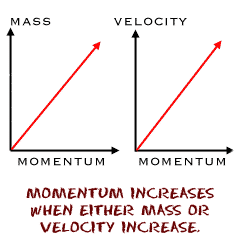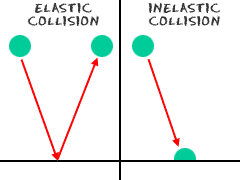Momentum Basics
 Momentum is another vector measurement. Momentum is in the same direction as velocity. Scientists calculate momentum by multiplying the mass of the object by the velocity of the object. It is an indication of how hard it would be to stop the object. If you were running, you might have a mass of 50 kilograms and a velocity of 10 meters per second west (really fast). Your momentum would be 500 kg-m/sec west. Easy as pi.
Momentum is another vector measurement. Momentum is in the same direction as velocity. Scientists calculate momentum by multiplying the mass of the object by the velocity of the object. It is an indication of how hard it would be to stop the object. If you were running, you might have a mass of 50 kilograms and a velocity of 10 meters per second west (really fast). Your momentum would be 500 kg-m/sec west. Easy as pi.
Remember Newton's First Law? It said that any object moving will continue moving unless it is interfered with. That idea applies to momentum as well. The momentum of an object will never change if it is left alone. If the 'm' value and the 'v' value remain the same, the momentum value will be constant.
 The momentum of an object, or set of objects (system), remains the same if it is left alone. Within such a system, momentum is said to be conserved.
The momentum of an object, or set of objects (system), remains the same if it is left alone. Within such a system, momentum is said to be conserved.
Here's the momentum idea in simpler terms. When you throw a ball at someone and it hits him hard, it hurts because it was difficult to stop (had momentum).Think about it. If you throw a small ball and a large ball at the same speeds, the large ball will hit a person with a greater momentum, be harder to stop, and hurt more. When the mass is greater (at the same speeds), the momentum is greater.
A bullet is an example of an object with a very small mass that has a lot of momentum because it is moving very quickly. Bullets are therefore difficult to stop; it's a good idea not to try!
Conserving Momentum
 We already told you that the momentum of an isolated object (or system of objects) is conserved. If the net force acting on an object is zero, then the linear momentum is constant. In an elastic collision (such as a superball hitting and rebounding from the ground), no kinetic energy is lost. All of that energy is still in the object, so we say that energy was conserved. If the kinetic energy didn't change, then neither did the value of the momentum (The momentum vector, however, DID change, since the direction of momentum changed.). Energy is a scalar, not a vector, so a direction change doesn't matter.
We already told you that the momentum of an isolated object (or system of objects) is conserved. If the net force acting on an object is zero, then the linear momentum is constant. In an elastic collision (such as a superball hitting and rebounding from the ground), no kinetic energy is lost. All of that energy is still in the object, so we say that energy was conserved. If the kinetic energy didn't change, then neither did the value of the momentum (The momentum vector, however, DID change, since the direction of momentum changed.). Energy is a scalar, not a vector, so a direction change doesn't matter.
What about an inelastic collision? In an inelastic collision, some of the energy will be lost to heat or sound or light or some other energy. The thing to remember is that the total energy didn't change, but some of it escaped into the air, ground, etc. The object would then have less energy when it rebounded, so the KE and momentum would be less. The total energy is the same, but the energy of the object did not remain the same. The energy of the object was not conserved, but the total energy was.
Try throwing a piece of clay on the ground. When the clay slams into the ground, some of the kinetic energy of the clay was lost as heat and sound to the ground and air, and some of the heat remains in the clay. Since the velocity became zero, so did the momentum. The energy is still around, but divided up in different places.
Or search the sites for a specific topic.
- Overview
- Forces
- Vectors
- Laws of Motion
- Energy of Motion
- Velocity
- Momentum
- Friction
- Gravity
- Work
- More Topics

How Pulleys Work (NASA-eClips Video)

Useful Reference Materials
Encyclopedia.com:http://www.encyclopedia.com/topic/momentum.aspx
Encyclopedia.com (Angular Momentum):
http://www.encyclopedia.com/topic/Angular_momentum.aspx
Wikipedia:
http://en.wikipedia.org/wiki/Momentum
Encyclopædia Britannica:
http://www.britannica.com/EBchecked/topic/388629/momentum





